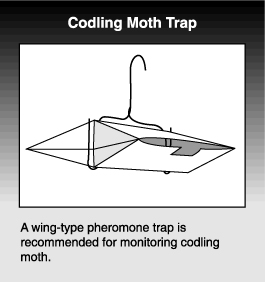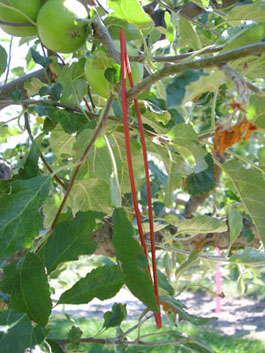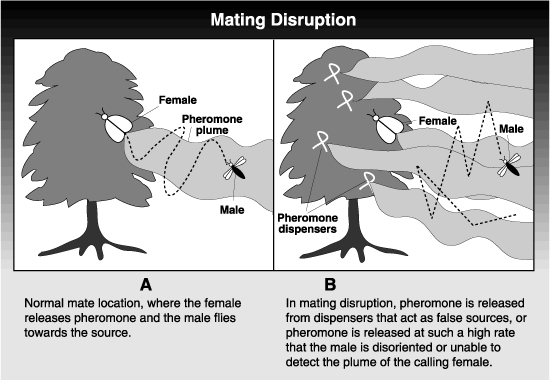by Jay F. Brunner and Alan Knight, originally published 1993
Mating disruption involves the use of sex pheromones to prevent male insects finding females and mating. Pheromones are chemicals produced by an insect to communicate in some way with others of the same species.
There are several types of pheromones. For example, ants lay a trail pheromone to direct other ants to a food source. Aphids release an alarm pheromone that warns other aphids of potential danger, usually the presence of a predator or parasite. Sex pheromones are chemicals released by female insects to attract males from long distances to mate. A female releasing a pheromone is said to be ”calling” the male. The male flies upwind, crisscrossing the pheromone plume, following the increasing concentration until it finds the source. After mating, the female stops calling.
Pheromones of many different insects have been identified and synthesized. When a small amount of a species’ pheromone is put into a rubber or plastic dispenser and placed in a trap, males of that species are attracted to the trap as they would be to a calling female. These pheromone traps are used to monitor the activity or even estimate the density of some Lepidoptera that are pests of fruit crops.
 The pheromone of most moths has from 2 to 6 components. Different components or different ratios of the same components make them specific attractants for a species. For example, several leafroller species have pheromones with the same components. Specificity results from components being present in different ratios in different species.
The pheromone of most moths has from 2 to 6 components. Different components or different ratios of the same components make them specific attractants for a species. For example, several leafroller species have pheromones with the same components. Specificity results from components being present in different ratios in different species.
Other insects, such as campylomma, scales and mealybug, also produce pheromones and may be candidates for mating disruption. After mating, the female stops calling.
Pheromones of many different insects have been identified and synthesized. When a small amount of a species’ pheromone is put into a rubber or plastic dispenser and placed in a trap, males of that species are attracted to the trap as they would be to a calling female. These pheromone traps are used to monitor the activity or even estimate the density of some Lepidoptera that are pests of fruit crops.
The pheromone of most moths has from 2 to 6 components. Different components or different ratios of the same components make them specific attractants for a species. For example, several leafroller species have pheromones with the same components. Specificity results from components being present in different ratios in different species.
Other insects, such as campylomma, scales and mealybug, also produce pheromones and may be candidates for mating disruption.
How mating disruption works
There are several ways mating disruption may work. Dispensers in the orchard might mimic a calling female, attracting the male to many false sources, or dispensers might release so much pheromone that the background concentration masks normal communication.
It is important to understand how mating disruption works because different mechanisms can influence how pheromones should be used in the orchard. Four different mechanisms have been proposed to explain how mating disruption works. It is possible that for a pest species more than one of these mechanisms could be operating at the same time to achieve control. The mechanisms are:
Adaptation or habituation
Long-term exposure to a stimulus can affect the sensory organs or nervous system of an insect so it does not function properly. Moths detect pheromones through olfactory receptors on their antennae.
- Adaptation occurs when sensory organs are exposed constantly to high and uniform levels of pheromone in the orchard, inhibiting their ability to detect the pheromone. Adapted sensory organs recover rapidly, in 2 to 3 seconds, when they are no longer exposed to the pheromone.
- Habituation occurs when high concentrations of a pheromone inhibit the insect’s ability to respond for several minutes or even a few hours. The effect is apparently on the nerve that fires in response to high concentrations but does not recover normally. Then, when exposed to a normal amount of pheromone, the nerve does not send the proper signal. Habituation could play an important role in mating disruption by making males less responsive for long periods after exposure to high concentrations of pheromone.
False trails
Unlike habituation or adaptation, this mechanism assumes the male moth can still sense and respond to the pheromone. If numerous sources of pheromone are placed in the orchard, male moths would spend time and energy following pheromone trails to false sources. If there were enough false sources, the chances of a male finding a calling female would be very low. Ideally, the false pheromone sources would be distributed evenly and would all emit about the same amount of pheromone as a calling female.
Most dispensers used in mating disruption release much more pheromone than a calling female. While male moths are no longer attracted to a pheromone source when the concentration gets too high, false-trail following might still be the mechanism at work. The male moths may follow false pheromone trails until they reach concentrations that are too high and no longer attractive.
Masking
This mechanism also assumes the moth’s sensory system is working normally. In this case, the background level of the pheromone is high and uniform enough to mask the odor trail from a calling female. The male’s normal navigation system for finding a mate is useless in the pheromone fog.
Imbalanced sensory input
The pheromone of most moths has more than one component. Even where the pheromones of different species have the same components, different ratios make them distinctive. If a single component of the pheromone, or an altered ratio of components, is released, males might not be able to detect or find the blend of pheromone released by females. If they continually receive signals that are out of balance with the one their sensory system is designed to pick up, their mate-seeking behavior might be inhibited. Antipheromones are chemicals that resemble the true pheromone or may have completely different chemical structures. It is possible that some antipheromones compete with the true pheromone for the same receptor sites on the moths’ sensory organs. However, some antipheromones that do not chemically resemble the true pheromones may also block mate location.
Pheromone dispensers

The dispensers used to release a pheromone in mating disruption are just as important as using the right chemicals. If the right pheromone is used, but is released too slowly, then the concentration in the atmosphere might be too low to block mate finding. If, on the other hand, the dispenser releases pheromone too fast, control might not last as long as needed.
Several types of dispensers have been used in mating disruption tests. Pheromones have been impregnated in rubber tubing, incorporated in plastic wafers, placed inside hollow fibers and even formulated into sprays.
The most common dispenser systems used in mating disruption on fruit crops incorporate pheromones in plastic tubes, ampules or packets designed to release the product slowly over several weeks. The dispensers are usually placed in the orchard by hand, at a rate of 150 to 400 per acre. Different dispenser systems containing the same pheromone may not provide the same level of pest control. It will take careful research on each type of dispenser system to find out how well they disrupt mating.
Benefits of mating disruption
Improved biological control
The use of mating disruption to control a key pest, such as codling moth, would reduce the use of broad-spectrum insecticides in Pacific Northwest orchards and improve biological control of many other pests.
In 1989, more than a third of all insecticides applied in Washington orchards were aimed at codling moth. Secondary pests, such as aphids, leafhoppers and leafminers, have developed resistance to insecticides used against codling moth so orchardists have also had to apply other insecticides to control those insects. Eliminating the broad-spectrum organophosphates used to control codling moth would allow better survival of natural enemies of aphids, leafhoppers and leafminers. In many orchards, these secondary pests could eventually be controlled by their natural enemies.
Use of mating disruption over several years could suppress pest populations to very low levels or even lead to local eradication. Under these conditions, controls may be suspended until pest populations increase again. The recovery of the pest population could be monitored with pheromone traps or by inspecting fruit at harvest.
Slower development of pesticide resistance
Pesticide resistance is all too common in agriculture. Mating disruption is an alternative control tactic that could help slow the development of resistance to insecticides. It is important to conserve the usefulness of insecticides at a time when many are being lost in the re-registration process.
Less exposure to pesticides
Exposure of farm workers to insecticide residues during fruit thinning and harvest is another important issue. Pheromones are not toxic to mammals at the levels released in mating disruption programs. Because the chemicals are enclosed in the dispenser packet, workers are not directly exposed to them.
No residues
Because pheromones are not applied directly to the fruit, there are no residues on the crop. The use of mating disruption to control key pests could help reduce the already low levels of insecticide residues on fruit. Consumers who have difficulty understanding the complex issues of food safety would welcome technology that reduces chemical residues on their food.
Factors influencing mating disruption
Size and location of orchard
Mating disruption may not work for every insect that communicates by pheromones nor will it work equally well in every location. The success of mating disruption can be influenced by orchard size and isolation. In small orchards (less than 10 acres) or in larger ones near a source of the pest, mating disruption may not provide reliable control. The pheromone does not kill the pest; thus, mated females can fly into the treated area and lay eggs, producing larvae that will cause damage. For an insect like codling moth, isolation of between 50 and 100 meters (55 to 110 yards) should be adequate. Border sprays may be needed as part of a mating disruption program if a source of the pest is nearby.
Pest levels
Mating disruption alone will normally not be adequate to reduce high pest populations to nondamaging levels. It is primarily intended as a tactic to keep pest populations low. The first year in which mating disruption is used, insecticidal control may be required to reduce pest populations to levels that can then be maintained by pheromones alone.
Nontarget pests
The highly selective nature of mating disruption has a negative side. Pests that were kept at nondamaging levels by insecticides aimed at the target pest of mating disruption will be released from control. Predators and parasites will keep some of these pests below damaging levels, but others may have to be controlled with insecticides. Thus, the switch to mating disruption as a control for codling moth does not mean that insecticides will not be needed to control other pests.
Monitoring
More intensive monitoring will be needed in a mating disruption program. Because the target of mating disruption is not killed by the treatment, its activity and density in the orchard must be followed to ensure adequate control. Although monitoring has been encouraged in the past, the reliance on insecticides for control meant little was actually done. To take full advantage of mating disruption and the increased potential for biological control of other pests, it will be necessary to monitor populations of pests and their natural enemies.
Cost
The cost of mating disruption will be higher than conventional chemical control, at least in the short term. In 1991, the cost of a mating disruption program for codling moth in apple averaged about 50% more than an average chemical control program. Cost differences between mating disruption and conventional programs could lessen if sprays for secondary pests, such as aphids and leafminers, are eliminated because of better controls. However, if pests that had been controlled by codling moth sprays increase, additional sprays might be needed.
Other factors
Other factors might influence the success of mating disruption, and these need further research. The uniformity of the orchard canopy can affect distribution of the pheromone, leaving areas where control could fail. In orchards on windy sites or steep slopes, the pheromone might not be evenly distributed throughout the orchard or might not be in high enough concentrations to provide control. Weather patterns could also influence the success of mating disruption. Mating disruption in regions with high summer temperatures might require dispensers with different release rates than those in cooler regions.
Mating disruption in the Pacific Northwest
Several characteristics of fruit production in the Northwest make mating disruption appealing and may contribute to its success.
Pest complex
The insect pest complex attacking fruit crops in the Pacific Northwest is smaller than in the eastern United States. The absence of pests such as the apple maggot and plum curculio should make mating disruption for codling moth and leafrollers more feasible because if these pests were present 3 to 5 additional insecticide treatments would be needed. Also, populations of most pests, especially codling moth, are already low in most commercial orchards because of broad-spectrum insecticide use. This means that mating disruption could be implemented immediately without having to reduce pest levels first.
Contiguous plantings
Most orchards in the Pacific Northwest are not isolated units, but contiguous plantings, often of several hundred acres. That, plus the tradition of controlling pests on a regional basis, could work to increase the chances of success of mating disruption.
Lack of alternate hosts
The habitat surrounding most Northwest orchards does not contain alternate host plants for the targets of mating disruption. The chance of pests immigrating from native habitats is thus much lower than in regions where orchards are surrounded by hosts for target pests.
Natural enemies
Without the disruption caused by broad-spectrum insecticides, natural enemies can provide biological control of some pests. This is especially true for the western tentiform leafminer and possibly the apple aphid, white apple leafhopper and grape mealybug. Although more research is needed, there is evidence that orchardists would be able to rely more on biological control where mating disruption is used for codling moth control.
Regulation and registration
The U.S. Environmental Protection Agency (EPA) regulates only certain uses of pheromones. The use of pheromones in traps to monitor insects is not regulated. However, if the intent is to prevent, destroy, repel or otherwise mitigate a pest population, the EPA considers pheromone a pesticide and regulates its use through registration.
The EPA has recognized that pheromones are inherently different from conventional pesticides and supports the concept of mating disruption as an environmentally safe pest control tactic. Pheromones have a unique, nontoxic mode of action, are highly specific, occur naturally, and are used in very low volumes.
The EPA has developed a tiered testing scheme to ensure that the minimum amount of data is needed to register them. Pheromones do not need to undergo further testing if they pass all the first tier data requirements. The EPA has waived the requirement for a tolerance on food crops, as the chances of residues are nil. The EPA has registered pheromone products to control oriental fruit moth, peachtree borer and codling moth, as well as pests on some nonfood crops. It has taken much less time to register these products than to register conventional pesticides.
Mating disruption successes
One of the most successful examples of mating disruption has been on oriental fruit moth. Control of oriental fruit moth with a pheromone has been reported to be as good as or better than with conventional insecticidal control in several orchards in California. The pheromone was registered in 1986 and in 1990 was used on 10,000 acres of peach orchards in Washington and California.
A pheromone product to control codling moth was registered in 1991. Research has produced mixed results, although under the right conditions the product has given good control.
